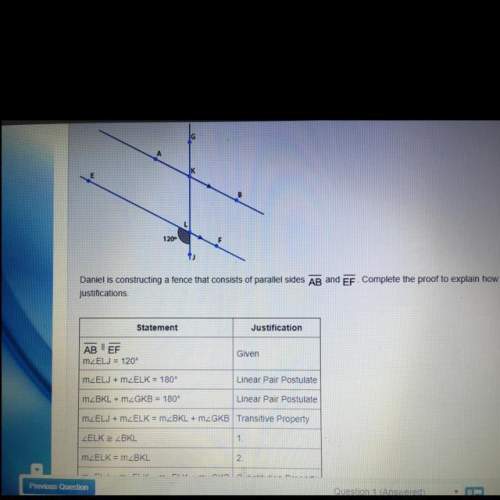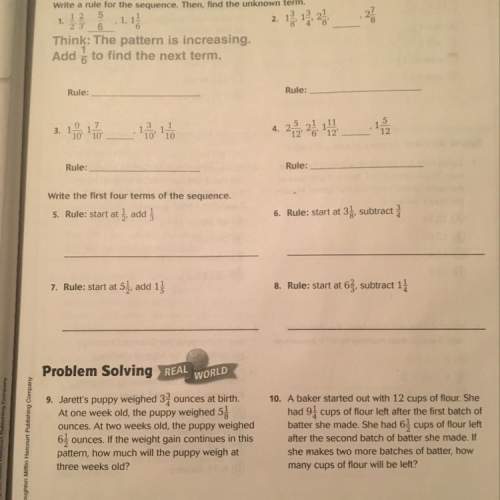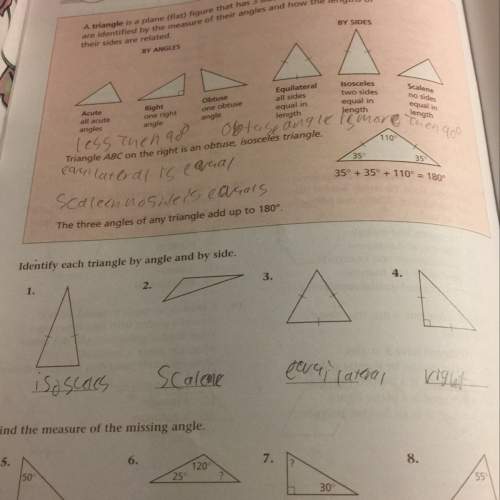
Mathematics, 26.11.2019 00:31 dez73
Daniel is constructing a fence that consists of parallel sides ab and ef. complete the proof to explain how he can show that the measure of angle gkb = 120° by filling in the missing justifications.
option a: 1. alternate interior angles theorem; 2. definition of congruence
option b: 1. alternate exterior angles theorem; 2. substitution property
option c: 1. definition of congruence; 2. alternate interior angles theorem
option d: 1. substitution property; 2. alternate exterior angles theorem


Answers: 1
Another question on Mathematics

Mathematics, 21.06.2019 15:00
In a circle, a 45° sector has an area of 32π cm2. what is the radius of this circle? 32 cm 12 cm 16 cm 8 cm
Answers: 3

Mathematics, 21.06.2019 22:00
Jayne is studying urban planning and finds that her town is decreasing in population by 3% each year. the population of her town is changing by a constant rate.true or false?
Answers: 3

Mathematics, 22.06.2019 03:00
Graph the equation 8x - 4y = 56. then, trace the graph to find the missing value in the coordinate pairs below: (-10, 140 ) (0, ) (2, ) (4, ) ( , 0)
Answers: 2

Mathematics, 22.06.2019 03:00
In this problem, we explore the effect on the standard deviation of multiplying each data value in a data set by the same constant. consider the data set 14, 6, 8, 15, 15. (a) use the defining formula, the computation formula, or a calculator to compute s. (round your answer to one decimal place.) s = 4.28 (b) multiply each data value by 3 to obtain the new data set 42, 18, 24, 45, 45. compute s. (round your answer to one decimal place.) s = 12.83 (c) compare the results of parts (a) and (b). in general, how does the standard deviation change if each data value is multiplied by a constant c? multiplying each data value by the same constant c results in the standard deviation remaining the same. multiplying each data value by the same constant c results in the standard deviation being |c| times as large. multiplying each data value by the same constant c results in the standard deviation increasing by c units. multiplying each data value by the same constant c results in the standard deviation being |c| times smaller. (d) you recorded the weekly distances you bicycled in miles and computed the standard deviation to be s = 3.8 miles. your friend wants to know the standard deviation in kilometers. do you need to redo all the calculations? yes no given 1 mile ≠1.6 kilometers, what is the standard deviation in kilometers? (enter your answer to two decimal places.)
Answers: 1
You know the right answer?
Daniel is constructing a fence that consists of parallel sides ab and ef. complete the proof to expl...
Questions


History, 04.03.2021 21:10



Mathematics, 04.03.2021 21:10

Mathematics, 04.03.2021 21:10

Mathematics, 04.03.2021 21:10

Mathematics, 04.03.2021 21:10



Mathematics, 04.03.2021 21:10

Mathematics, 04.03.2021 21:10

History, 04.03.2021 21:10

Physics, 04.03.2021 21:10


Mathematics, 04.03.2021 21:10

Mathematics, 04.03.2021 21:10



Mathematics, 04.03.2021 21:10





